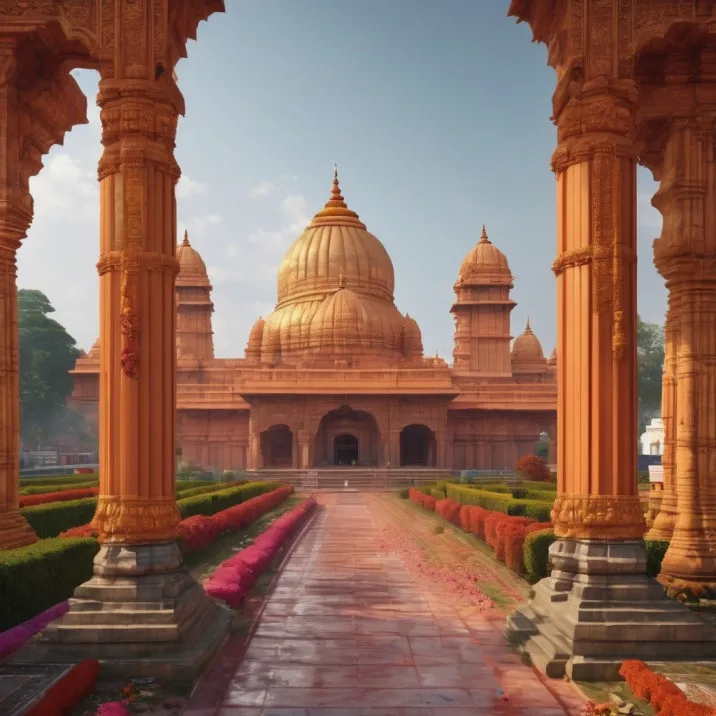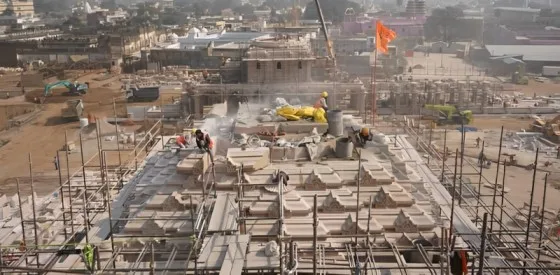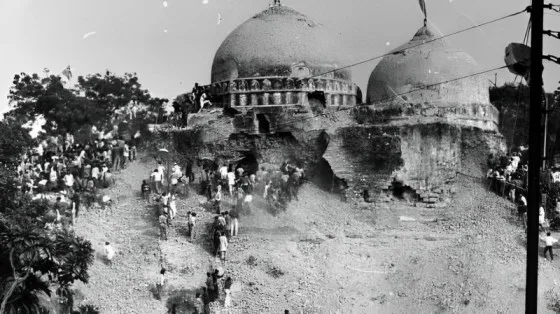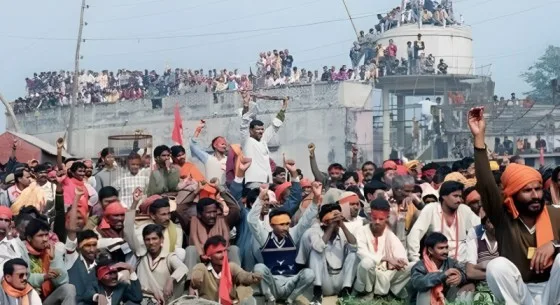Ayodhya Ram Mandir: A Symbolic Journey of Faith and Cultural Identity
Introduction:
The Ayodhya Ram Mandir stands as a testament to the rich tapestry of India’s cultural and religious diversity. This blog aims to unravel the layers of history, legal intricacies, and the socio-cultural impact surrounding the construction of this iconic temple.
Historical Context:
Ayodhya: The Birthplace of Lord Ram

Ayodhya, nestled on the banks of the Sarayu River, has been revered for centuries as the birthplace of Lord Ram, a significant figure in Hindu mythology. The city’s history is interwoven with the epic Ramayana, making it a pilgrimage site for millions of devotees.
The Ayodhya Dispute:
The Ayodhya dispute emerged due to conflicting claims over the site where the Babri Masjid stood. Hindus believed it to be the birthplace of Lord Ram, while Muslims considered the mosque a historical and religious structure.
Legal Battle:
The Babri Masjid Demolition:
The demolition of the Babri Masjid in 1992 intensified religious tensions and ignited a legal battle that spanned decades. The dispute became one of the most complex and sensitive issues in Indian history, involving numerous court hearings and legal interventions.
Landmark Supreme Court Verdict:
In a historic verdict in 2019, the Supreme Court of India settled the Ayodhya dispute by allocating the disputed land for the construction of the Ram Mandir. The judgment aimed to reconcile religious sentiments while upholding the principles of justice and secularism.
Cultural and Religious Significance:
Architectural Marvel:
The Ayodhya Ram Mandir is envisioned as an architectural marvel, combining traditional Indian craftsmanship with modern engineering techniques. The temple’s design reflects ancient Vedic architecture, creating a sacred space that resonates with devotees.
Religious Harmony:
While the construction of the Ram Mandir fulfills the aspirations of millions of Hindus, it also underscores the need for religious tolerance and coexistence. The project has witnessed support from various religious communities, fostering a spirit of unity and harmony.
Socio-Political Impact:
Uniting a Nation:

The Ayodhya Ram Mandir has played a pivotal role in fostering a sense of national unity. Its construction symbolizes the recognition of India’s diverse cultural heritage and serves as a unifying force transcending religious and regional divides.
Political Ramifications:
The Ayodhya issue has not only been a religious and cultural matter but has also had significant political ramifications. Various political parties have leveraged the dispute to consolidate their support base, making it a complex intersection of religion and politics.
Conclusion:
The construction of the Ayodhya Ram Mandir marks the culmination of a journey that spans centuries, blending religious fervor, legal intricacies, and socio-political dynamics. As India looks towards the future, the temple stands as a symbol of unity, fostering a spirit of inclusivity and understanding that transcends differences. The Ayodhya Ram Mandir is not merely a physical structure but a testament to the resilience of faith and the enduring cultural identity of a nation.
Ram Mandir Controversy: A Complex Journey of Faith and Dispute
Introduction:
The Ram Mandir controversy, centered around the construction of a temple at the Ram Janmabhoomi site in Ayodhya, is a multifaceted saga blending history, faith, and legal intricacies. This article endeavors to unravel the complexities surrounding this long-standing dispute and its profound impact on India.
Historical Context:
Ayodhya: The Sacred Birthplace
Ayodhya holds immense religious significance for Hindus, believed to be the birthplace of Lord Ram. The controversy traces its roots to the Mughal era when the Babri Masjid was constructed on a site claimed by Hindus as the birthplace of their revered deity.
Legal Battles:
Title Suits and Disputed Claims
The Ram Mandir controversy transitioned into the legal arena with multiple parties filing title suits, claiming ownership of the disputed site. The legal battle became protracted, spanning several decades and involving various courts grappling with questions of historical evidence, faith, and property rights.
1992 Demolition of Babri Masjid
The controversy reached a boiling point on December 6, 1992, when the Babri Masjid was demolished by a mob, escalating communal tensions across the nation. This event marked a watershed moment, intensifying the dispute and leaving indelible scars on the country’s social fabric.
The Path to Resolution:
Supreme Court Verdict (2019)
In a historic verdict in 2019, the Supreme Court of India settled the Ram Mandir controversy by allocating the disputed land for the construction of the Ayodhya Ram Mandir. The judgment aimed to balance the scales of justice while recognizing the deep-seated religious sentiments of millions.
Cultural and Religious Significance:
Architectural Marvel of the Ram Mandir
The proposed Ayodhya Ram Mandir is envisioned as a grand architectural marvel, reflecting traditional Indian craftsmanship and modern engineering. Its design pays homage to ancient Vedic architectural principles, creating a sacred space that resonates with devotees.
Unity in Diversity
While the construction of the Ram Mandir fulfills the aspirations of Hindus, it also underscores the importance of religious tolerance and coexistence. The project has received support from various religious communities, emphasizing the potential for unity in India’s diverse cultural landscape.
Socio-Political Impact:
A Symbol of National Unity
The Ram Mandir controversy has left an enduring impact on India’s socio-political landscape. The construction of the temple is seen as a symbol of national unity, acknowledging the country’s diverse cultural heritage.
Political Ramifications
The controversy has not only been a religious and cultural matter but has also had significant political ramifications. Various political parties have navigated the issue to consolidate their support base, making it a complex intersection of religion and politics.
Conclusion:
The resolution of the Ram Mandir controversy signifies the end of a tumultuous chapter, albeit one that has left a lasting imprint on the collective consciousness of a nation. As the Ayodhya Ram Mandir takes shape, it stands as a testament to the resilience of faith, the pursuit of justice, and the potential for unity in the face of complex and deeply rooted disputes.
Title: Unraveling the Controversy: The Battle of Babri Masjid and Its Enduring Impact
Meta Description:
Dive into the tumultuous history of the Babri Masjid controversy, a historical and religious dispute that shook the foundations of Indian society. This comprehensive exploration delves into the roots of the conflict, the events leading to the demolition of the mosque, and the far-reaching consequences that have left an indelible mark on the nation’s collective memory.
Introduction:
The Battle of Babri Masjid stands as a poignant chapter in India’s history, marked by religious tensions, legal complexities, and a socio-political landscape forever changed. This article endeavors to shed light on the controversy surrounding the Babri Masjid, a symbol of conflicting beliefs that has left an enduring impact on the cultural fabric of the nation.
Historical Context:
Babri Masjid: A Symbol of Religious Coexistence
Built in the 16th century by Mughal emperor Babur, the Babri Masjid in Ayodhya was a historical and architectural marvel. For centuries, it stood as a symbol of religious coexistence, with Hindus and Muslims sharing the space for worship.
Emergence of the Controversy:
Claims of Hindu Sacredness

The controversy surrounding the Babri Masjid began in the 19th century when some Hindus claimed that the mosque was built on the birthplace of Lord Ram. This belief fueled tensions and laid the groundwork for a prolonged dispute that would span decades.
Legal Battle and Title Suit:
The dispute took a legal turn in the 20th century when multiple parties filed title suits claiming ownership of the disputed site. The legal battle intensified, with various courts grappling with the complexities of history, faith, and property rights.
Demolition of Babri Masjid:
A Fateful Day in 1992
The controversy reached its zenith on December 6, 1992, when the Babri Masjid was demolished by a frenzied mob of Hindu nationalists. This event not only shattered the physical structure but also ignited communal tensions across the country, leading to widespread violence and loss of life.
Aftermath and Legal Ramifications:
Communal Strife:
The demolition of Babri Masjid triggered one of the darkest periods of communal strife in independent India. Riots and violence erupted in various parts of the country, leaving scars that are still felt today.
Liberhan Commission:
To investigate the circumstances leading to the demolition, the government constituted the Liberhan Commission. Its report, submitted after 17 years, pointed to a web of political and religious conspiracies that contributed to the tragic event.
Socio-Political Impact:
Changing Political Landscape:
The Battle of Babri Masjid significantly altered India’s political landscape. The issue was exploited by various political parties to consolidate their vote banks, leading to a polarization that continues to influence electoral dynamics.
Ram Mandir Construction:
The Supreme Court’s verdict in 2019, allocating the disputed land for the construction of the Ram Mandir, closed one chapter of the Babri Masjid controversy. However, the scars of the past remain, serving as a reminder of the need for religious tolerance and social harmony.
Conclusion:
The Battle of Babri Masjid is a somber tale of a nation grappling with its history, faith, and identity. As India continues its journey, it is essential to learn from the lessons of the past, fostering an environment of tolerance, understanding, and coexistence. The Babri Masjid controversy may be a historical event, but its impact resonates in the collective consciousness of a diverse and complex nation.

